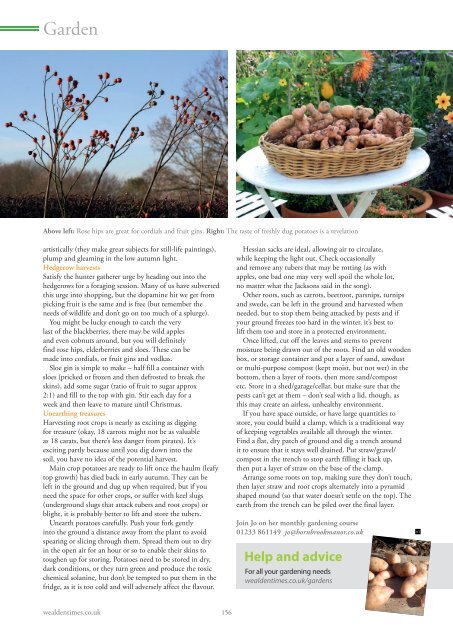Wealden Times | WT200 | October 2018 | Kitchen & Bathroom supplement inside
Wealden Times - The lifestyle magazine for the Weald
Wealden Times - The lifestyle magazine for the Weald
Create successful ePaper yourself
Turn your PDF publications into a flip-book with our unique Google optimized e-Paper software.
Garden<br />
Above left: Rose hips are great for cordials and fruit gins. Right: The taste of freshly dug potatoes is a revelation<br />
artistically (they make great subjects for still-life paintings),<br />
plump and gleaming in the low autumn light.<br />
Hedgerow harvests<br />
Satisfy the hunter gatherer urge by heading out into the<br />
hedgerows for a foraging session. Many of us have subverted<br />
this urge into shopping, but the dopamine hit we get from<br />
picking fruit is the same and is free (but remember the<br />
needs of wildlife and don’t go on too much of a splurge).<br />
You might be lucky enough to catch the very<br />
last of the blackberries, there may be wild apples<br />
and even cobnuts around, but you will definitely<br />
find rose hips, elderberries and sloes. These can be<br />
made into cordials, or fruit gins and vodkas.<br />
Sloe gin is simple to make – half fill a container with<br />
sloes (pricked or frozen and then defrosted to break the<br />
skins), add some sugar (ratio of fruit to sugar approx<br />
2:1) and fill to the top with gin. Stir each day for a<br />
week and then leave to mature until Christmas.<br />
Unearthing treasures<br />
Harvesting root crops is nearly as exciting as digging<br />
for treasure (okay, 18 carrots might not be as valuable<br />
as 18 carats, but there’s less danger from pirates). It’s<br />
exciting partly because until you dig down into the<br />
soil, you have no idea of the potential harvest.<br />
Main crop potatoes are ready to lift once the haulm (leafy<br />
top growth) has died back in early autumn. They can be<br />
left in the ground and dug up when required, but if you<br />
need the space for other crops, or suffer with keel slugs<br />
(underground slugs that attack tubers and root crops) or<br />
blight, it is probably better to lift and store the tubers.<br />
Unearth potatoes carefully. Push your fork gently<br />
into the ground a distance away from the plant to avoid<br />
spearing or slicing through them. Spread them out to dry<br />
in the open air for an hour or so to enable their skins to<br />
toughen up for storing. Potatoes need to be stored in dry,<br />
dark conditions, or they turn green and produce the toxic<br />
chemical solanine, but don’t be tempted to put them in the<br />
fridge, as it is too cold and will adversely affect the flavour.<br />
Hessian sacks are ideal, allowing air to circulate,<br />
while keeping the light out. Check occasionally<br />
and remove any tubers that may be rotting (as with<br />
apples, one bad one may very well spoil the whole lot,<br />
no matter what the Jacksons said in the song).<br />
Other roots, such as carrots, beetroot, parsnips, turnips<br />
and swede, can be left in the ground and harvested when<br />
needed, but to stop them being attacked by pests and if<br />
your ground freezes too hard in the winter, it’s best to<br />
lift them too and store in a protected environment.<br />
Once lifted, cut off the leaves and stems to prevent<br />
moisture being drawn out of the roots. Find an old wooden<br />
box, or storage container and put a layer of sand, sawdust<br />
or multi-purpose compost (kept moist, but not wet) in the<br />
bottom, then a layer of roots, then more sand/compost<br />
etc. Store in a shed/garage/cellar, but make sure that the<br />
pests can’t get at them – don’t seal with a lid, though, as<br />
this may create an airless, unhealthy environment.<br />
If you have space outside, or have large quantities to<br />
store, you could build a clamp, which is a traditional way<br />
of keeping vegetables available all through the winter.<br />
Find a flat, dry patch of ground and dig a trench around<br />
it to ensure that it stays well drained. Put straw/gravel/<br />
compost in the trench to stop earth filling it back up,<br />
then put a layer of straw on the base of the clamp.<br />
Arrange some roots on top, making sure they don’t touch,<br />
then layer straw and root crops alternately into a pyramid<br />
shaped mound (so that water doesn’t settle on the top). The<br />
earth from the trench can be piled over the final layer.<br />
Join Jo on her monthly gardening course<br />
01233 861149 jo@hornbrookmanor.co.uk<br />
Help and advice<br />
For all your gardening needs<br />
wealdentimes.co.uk/gardens<br />
wealdentimes.co.uk<br />
156


















